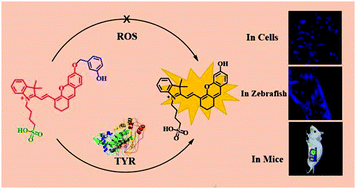A novel hydrosoluble near-infrared fluorescent probe for specifically monitoring tyrosinase and application in a mouse model†
Abstract
A novel hydrosoluble near-infrared (NIR) fluorescent probe that could specifically identify tyrosinase has been successfully constructed and applied for imaging of tyrosinase in living cells and zebrafish. Notably, the probe has been successfully applied to the diagnosis of melanoma in a xenogeneic mouse model.

- This article is part of the themed collection: Most popular analytical chemistry articles


 Please wait while we load your content...
Please wait while we load your content...